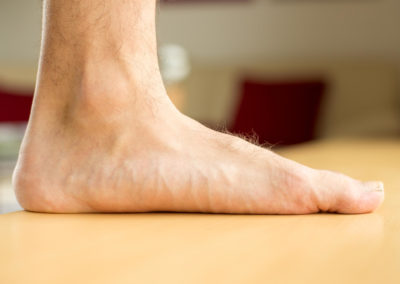Flat Feet
What is Flat Feet?
Flat feet (sometimes known as fallen arches or pes planus) refers to having a very low arch or no arch to the foot at all. Untreated this can lead to instability of the foot and ankle which in turn causes pain, deformity, and injury.
Custom orthotics can be used effectively to help the foot function more effectively and where there is over-pronation of the foot corrective surgery can be performed.
Overrpronation and Flat Feet
When your foot doesn’t have a healthy arch structure and rolls in excessively when you walk it is known as ‘overpronation or hyperpronation’ and this rolling can cause severe foot, ankle and knee pain. The excessive inward turning of the ankle bone can also affect your ability to walk normally.
Often overpronation can be controlled by insoles but for some people, this doesn’t work and surgery is required.
What Causes Flat Feet?
Many people simply inherit flat feet as it’s a condition that runs in the family but occasionally it’s a result of the feet bones not forming properly in the womb, or being hypermobile (double-jointed).
Sometimes the connective tissue in the foot can become stretched and inflamed – either as a result of over-use or through wearing unsupportive footwear, an injury or another issue.
What are the Treatment Options for Flat Feet?
There are a variety of treatment methods available to treat flat feet.
These range from stretches that can help ease the pain, to orthotics, to reconstructive surgery
Non-surgical Treatment Options
Wearing supportive shoes that fit well or adding custom orthotics to your shoes to support your feet and stop them rolling inwards can help reduce pain is always advised before any surgery is considered.
Surgical Treatment Options
There are a number of surgical options and the insertion of a HyProCure stent into the foot is one of a number of options available at Kann Foot Surgery.
The HyProCure stent is a titanium stent (tube) that is inserted to stabilise and realign the foot. The advantage of this procedure is that it does not require irreversible joint fusion and has a relatively quick recovery.
Not everyone benefits from this procedure and the indications for its use are limited to people who have mobile flat feet. If the stent is uncomfortable it can be removed.
It is expected that correction of your hyperpronation will have very positive benefits within the entire musculoskeletal chain although this cannot be guaranteed; soft tissue adaptation may take several months.
Occasionally, the Achilles tendon may need to be lengthened at the same time and, if it is needed, Mr. Kannegieter will discuss this in advance with you.
What Happens During Surgery?
Are There Risks or Side-Effects Following Foot Surgery?
As with any medical procedure, there are risks which Mr. Kannegieter will always thoroughly explain to you prior to your treatment, so you can be informed every step of the way.
The main risks following surgery are:
- Pain
- Swelling
- Infection
- Deep vein thrombosis
- Chronic pain syndrome (CRPS)
- Scarring
- Muscle Wasting
Specific risks following HyProCure Implant:
- Outcome of surgery cannot be guaranteed. The results may not be as successful as planned or as functional as expected and further surgery may be necessary.
- The implant can move in some patients. This can occur at any stage.
- Fracture of talus (ankle bone) or calcaneus (heel bone).
- Sprained ankle syndrome.
- Inability to tolerate the insertion, requiring removal of the stent.
- Movement or displacement of the stent
What Happens After Surgery?
After the operation you will be taken to the recovery ward for observation and then taken back to your room where you will be given a drink and food. You should start taking your painkillers. You will be discharged from the hospital having gone through the post-operative instructions with a member of the team, who will make sure that you are fit to leave hospital.
For more information on the HyProCure implant please click here.

Resources
Mr. Kannegieter has put together this useful PDF explaining what to expect from surgery for flat feet.
